
The Reginald A. Fessenden House is a historic house in the village of Chestnut Hill in Newton, Massachusetts. It was the residence from 1919 to his death in 1932 of the inventor Reginald A. Fessenden (1866–1932), called "the father of radio broadcasting," because he was the first to broadcast the human voice and music by radio. The house was designated a National Historic Landmark in 1976 in recognition of Fessenden's accomplishments.

The National Register of Historic Places is a United States federal official list of places and sites considered worthy of preservation. In the state of Massachusetts, there are over 4,300 listings, representing about 5% of all NRHP listings nationwide and the second-most of any U.S. state, behind only New York. Listings appear in all 14 Massachusetts counties.

The following properties in Newton, Massachusetts are listed on the National Register of Historic Places. They are a subset of all properties in Middlesex County. There are over 180 places listed in Newton.
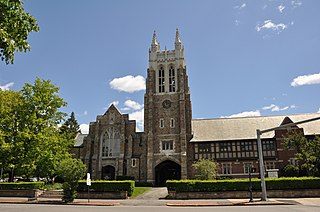
The First Unitarian Universalist Society in Newton occupies a prominent location at 1326 Washington Street in the heart of the village of West Newton in Newton, Massachusetts. Architect Ralph Adams Cram designed the church, Frederick Law Olmsted Jr. designed the grounds, the cornerstone was laid in 1905, and it was dedicated in 1906; it is one of the village's oldest buildings. The church is in Cram's signature Gothic Revival style, with buttressed walls and a blocky square tower with crenellations and spires. An enclosed courtyard is formed by an office wing, banquet hall, and parish house, which are built to resemble Elizabethan architecture with brick first floor and half-timbered upper level.
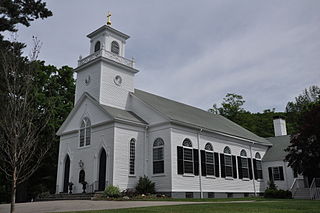
St. Mary's Episcopal Church and Cemetery is a historic church and cemetery at 258 Concord Street, in the village of Newton Lower Falls, Massachusetts, United States. St. Mary's Parish was formed in 1811. The church, built in 1813–14 and restyled in 1838, is the oldest church in Newton, and is a fine example of Gothic Revival/Federal style architecture. The cemetery, which dates from 1812, is the oldest non-government-owned cemetery in Newton. The property was listed on the National Register of Historic Places in 1980.

The Brandegee Estate is a historic estate at 280 Newton Street in Brookline and Boston, Massachusetts. Developed at the turn of the 20th century, it is one of the largest essentially intact estate properties in either community. It was developed by Mary (Pratt) Sprague, a direct descendant of Joseph Weld, one of Boston's first settlers, and is noted for its large Renaissance Revival mansion, and landscaping by Charles A. Platt. The estate was listed on the National Register of Historic Places in 1985. Its name derives from Mary Sprague's second husband, Edward Brandegee.
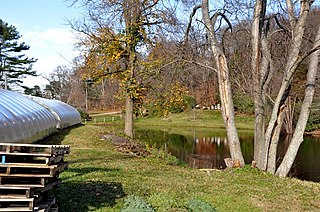
Allandale Farm, also known as the John Harris House and Farm, and once as Faulkner Farm, is an historic farm at 284 Newton Street in Chestnut Hill, Massachusetts. The main farm house, built c. 1778 and extensively remodeled in 1976, is one of Brookline's few 18th-century houses. The farm is the last working farm in both communities; it was added to the National Register of Historic Places in 1985.
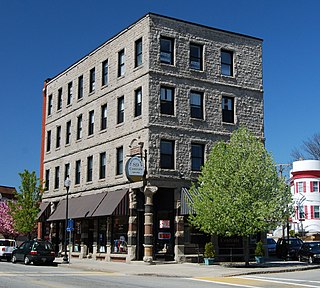
The Thom Block is an historic mixed-used commercial and residential building at 83-89 Main Street in Milford, Massachusetts. It is distinctive as being Milford's only building to be built out of locally quarried granite. The four-story building was built in 1891; its interior was gutted by fire shortly before its construction was completed. It originally housed three retail spaces on the ground floors, and two residential units on each of the upper floors.
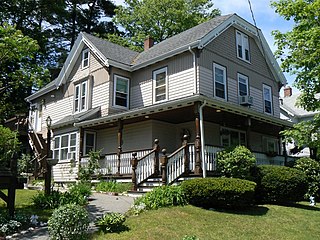
The Newton Lamson House is a historic house at 33 Chestnut Street in the Nobility Hill section of Stoneham, Massachusetts. Built c. 1887, it is one of Stoneham's finest Queen Anne/Stick style houses. It has a rectangular plan, with a gable roof that has a cross gable centered on the south side. The gable ends are clad in decorative cut shingles, and the gables are decorated with Stick-style vergeboard elements. Below the eaves hangs a decorative wave-patterned valance. The porch has turned posts and balusters. It is further enhanced by its position in the center of a group of stylish period houses, including the Sidney A. Hill House and the Franklin B. Jenkins House.

The Brandeis University President's House, also known as the Leland Powers House, is an historic house on 66 Beaumont Avenue in Newton, Massachusetts. Built in 1913–14 for Leland Powers, it is a prominent large-scale example of American Craftsman architecture. It has served as the official residence of two presidents of Brandeis University as well as Roger Berkowitz, the CEO of Legal Sea Foods. The house was listed on the National Register of Historic Places in 1998.
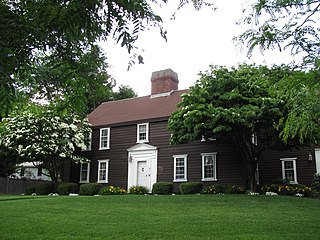
The Hammond House is an historic house located at 9 Old Orchard Road in the village of Chestnut Hill in Newton, Massachusetts. With an estimated construction date of 1645-1730, it is believed to be the oldest house in Newton. It is also a rare example of a First Period house that was started as a single cell, that was expanded to five bays later in the First Period; such expansion usually took place later in the 18th century, during the Georgian period. The house has been extended multiple times over the intervening centuries; the original core now lies just east of the main entrance. The original house was built by Hon. Ebenezer Stone when he moved from the Stone homestead at Mount Auburn in Watertown.

The E. C. Hammond House is a historic house at 35 Groveland Street in Newton, Massachusetts. The 1 3/4 story wood-frame house was built in 1909 and designed by its owner, Edward C. Hammond, a lumberman. The house is a simple but well-crafted and preserved example of Craftsman styling. It has a steep gabled roof, with a pergola porch across the front of the main façade. It retains its interior wood work and some original light fixtures.

The King House is a historic house at 328 Brookline Street in Newton, Massachusetts. This 2+1⁄2-story timber-frame house was built around 1710, probably by Jonathan Dyke, a cooper, and is one of Newton's few First Period houses, dating to the early period of its settlement. The house was given Greek Revival styling in the 19th century, and is also notable for its association with Noah King, a long-time prominent local doctor. It is five bays wide, with a side gable roof, twin interior chimneys, and clapboard siding. The main entrance has a Greek Revival surround with sidelight windows, wide pilasters, and an entablature. There is a "1695" dated plaque on the house which is the traditional/rumored date.

The Peabody-Williams House is a historic house at 7 Norman Road in Newton, Massachusetts. The 2+1⁄2-story wood-frame house was built in 1891, and is one of the finest Shingle style houses in the Newton Highlands area, with the asymmetrical massing, gabled projections and dormers, and corner turret typical of the style. It was designed by J. Williams Beal, and features extensive interior carving work by a locally prominent woodcarver, Andrew Lees.
Newton House may refer to:

Chestnut Hill Reservation is a public recreation area and historic preserve surrounding the Chestnut Hill Reservoir in the Chestnut Hill and Brighton neighborhoods of Boston, Massachusetts, United States. The reserve is part of the Chestnut Hill Reservoir Historic District, is listed on the National Register of Historic Places, and is a City of Boston Landmark. It is managed by the Department of Conservation and Recreation.

The Taylor Memorial Library, also known as Taylor Library or Old Library, is a historic former library building at 5 Broad Street in Milford, Connecticut. Built in 1894, it is a Richardsonian Romanesque building designed by Joseph W. Northrop. It follows, but departs from, H. H. Richardson's design of the Crane Memorial Library in Massachusetts. The building was listed on the National Register of Historic Places in 1979. It now houses the offices of the Milford Chamber of Commerce.

The U.S. Post Office-Milford Main, also known as Milford Main Post Office, is a historic post office building at 6 West River Street in Milford, Connecticut. It is a red brick building, trimmed with limestone, that was designed by James A. Wetmore and completed in 1931. It is a fine local example of Classical Revival design, making a significant contribution to a cluster of civic buildings around a triangular park north of Milford's commercial district. The building was listed on the National Register of Historic Places in 1986.

The William Peabody House is a historic house on North River Road in Milford, New Hampshire. This 2+1⁄2-story wood-frame house was built c. 1740 by William Peabody, the first English settler of the Milford area, and remains a good example of Georgian residential architecture despite a 1973 fire. The house was listed on the National Register of Historic Places in 1979.

Wilton Town Hall is located at 42 Main Street in downtown Wilton, New Hampshire. Built in 1886, the red brick building is a prominent local example of civic Queen Anne style architecture. In a common style of the day, it includes a theater space which was used for dramatic presentations, silent films, and vaudeville productions, before being converted to its present use as a movie theater. The building was listed on the National Register of Historic Places in 2009.






















